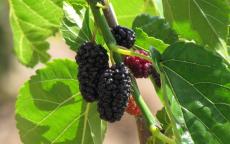Mulberry trees
Beautiful Day
Beautiful Day is a sweet-flavoured white mulberry.- Picking season: Mid
- Self-fertility: Self-fertile
Black Italia
Black Italia is a modern hybrid mulberry with a naturally sweet flavour.- Picking season: Mid
- Self-fertility: Self-fertile
Illinois Everbearing
An American hybrid mulberry, producing long black fruits from an early age.- Self-fertility: Self-fertile
Kagayamae White
Kagayamae White is a fruiting form of the Plane Tree Mulberry, known for its dense leaves.- Picking season: Mid
- Self-fertility: Self-fertile
Leonard
A productive white mulberry with very sweet perfumed dull-red fruits.- Picking season: Mid
- Self-fertility: Self-fertile
Wellington
A traditional English black mulberry tree featuring large dark sweet fruits.- Self-fertility: Self-fertile
Yugoslavia
Yugoslavia is a traditional mulberry from south-east Europe.- Picking season: Mid
- Self-fertility: Self-fertile

